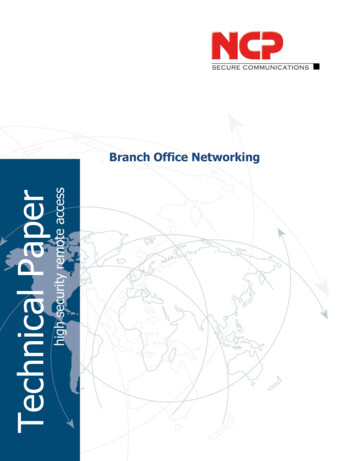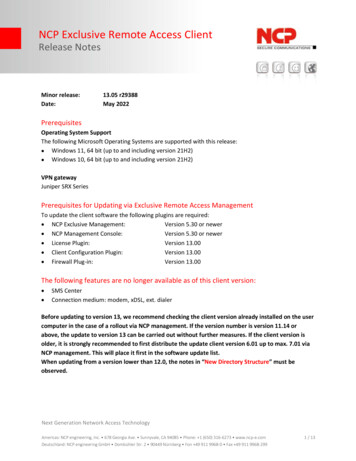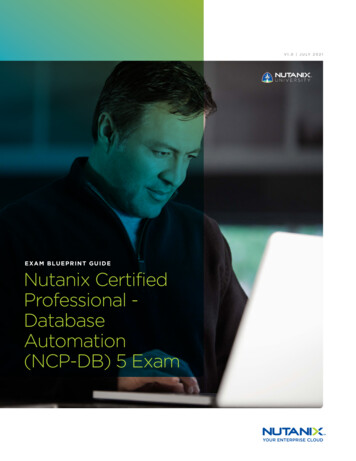
Transcription
Technical PaperBranch Office Networking
Branch Office NetworkingNetworkCommunicationsProducts engineeringSupportUSA:NCP engineering, Inc.444 Castro Street, Suite 711Mountain View, CA 94041Tel.: 1 (650) 316-6273Fax: 1 (650) 251-4155Germany:NCP engineering GmbHDombuehler Str. 2D-90449 NurembergTel.: 49 (911) 9968-0Fax: 49 (911) 9968-299Internethttp://www.ncp-e.comNCP offers support for all international usersby means of Fax and Email.Email sh)(German)Fax 1 (650) 251-4155 49 (911) 9968-458(USA)(Europe)When submitting a support request, pleaseinclude the following information: exact product name serial numberEmailinfo@ncp-e.com version number an accurate description of your problem any error message(s)CopyrightWhile considerable care has been taken in the preparation and publication of this manual, errors incontent, typo-graphical or otherwise, may occur. If you have any comments or recommendations concerning the accuracy, then please contact NCP. NCP makes no representations or warranties with respect to the contents or use of this manual, and explicitly disclaims all expressed or implied warrantiesof merchantability or suitability of use for any particular purpose.Furthermore, NCP reserves the right to revise this publication and to make amendments to the contents, at any time, without obligation to notify any person or entity of such revisions or changes. Thismanual is the sole property of NCP and may not be copied for resale, commercial distribution or translated to another language without the express written permission of NCP engineering GmbH.All trademarks or registered trademarks appearing in this manual belong to their respective owners. 2014 NCP engineering GmbH, All rights reserved. NCP engineering info@ncp-e.com www.ncp-e.com Subject to change without noticePage 2 of 7
Branch Office NetworkingWhat is required for secure and efficient networking of branch officesand the company headquarters?A site-to-site VPN is used to connect independent networks, for example, for branchoffice networking. In most cases this means that the branch office networks are connected to the network of the company headquarters. Another possibility is machine-tomachine (M2M) networking. In this case it is machines that communicate with the central gateway. In all cases VPN gateways are used. They establish a connection to theInternet, then they encode and authenticate the IP user data for transmission and tunnel it through the Internet. IPsec is the VPN protocol that is most frequently used forthese types of connection.This article discusses aspects of branch office networking that are frequently disregarded during planning or extending site-to-site VPNs. However, these aspects cause problems none the less.Types of networksMeshed or star-shaped networks are the two options for branch office networking. Withmeshed networks, the branch offices are not only connected to the headquarters butalso amongst each other. With star-shaped networks, however, all communication between the branch offices is channeled through one central VPN gateway. This results inhigher latency in communication between the branch offices. However, a clear advantage of star-shaped networks is that IT administrators control the whole networkvia one central monitoring system. Hence, star-shaped networks allow for real timedetection and locating communication faults between the branch offices. However, thisrequires a central VPN management system. Should communication faults occur in thecrosslinks of a meshed network, however, locating them is much more difficult. If anetwork, for example, contains 100 branch offices, controlling this network wouldcause substantial extra effort.High AvailabilityThe criteria of availability differ, depending on which branch offices are connected tothe main network. This means high availability has to be guaranteed for branch officeswhich must not break down; common examples are branch offices of banks and theirATM's or checkout systems of retail chains. In order to guarantee high availability,professional VPN systems support several backup systems.Monitoring the VPN connection is a basic requirement for being able to carry out backups. One method of connection monitoring is DPD (Dead Peer Detection- RFC). On topof that, the VPN gateway of the branch office should support several alternative mediatypes (communication mediums) for Internet dial up. The VPN solution should be ableto automatically recognize a communication fault with a remote side. If it does, theVPN gateway disconnects the standard connection automatically a sets up an alternative backup link. Most modern VPN software solutions support infinite backup connections. With these solutions, the restricting factor is the number of communication mediums the hardware supports. NCP engineering info@ncp-e.com www.ncp-e.com Subject to change without noticePage 3 of 7
Branch Office NetworkingCentral ManagementA central VPN management system is required for effective networking of branch offices. Even if there are only a few branch offices, the time and money that has to bespent on local network administration is out of proportion. With M2M, such kind of administration this is hardly possible.Central management automates management of remote / branch office VPN gateways.The more VPN relevant systems the central management contains, the simpler andmore manageable the network becomes for administrators. Apart from configurationand software update management the following tasks should be included into the management software, too: management of digital software or hardware certificate (CA)rollout, an LDAP console for identity and rights management as well as security monitoring of the end-devices (Network Access Control / Endpoint Security).Image 1: Multiple VPN Management Console NCP engineering info@ncp-e.com www.ncp-e.com Subject to change without noticePage 4 of 7
Branch Office NetworkingA VPN system secures all data transfers in an encrypted tunnel. However, sealing ofthe communication has to take place as early as Internet dial up, which is the mostfrequent point of vantage of hacker attacks. The core problem is how the branch officesauthenticate towards the central gateway. One possibility for authentication are preshared keys, another is the use of certificates. For security reasons certificates are thebetter option, because they can be adapted. This means old certificates can be lockedand new ones can be issued. Certificate handling has to be organized; i.e. if one certificate expires, the VPN management should offer automatisms that request and issuenew certificates.At times, a further security requirement is simply overlooked: The firewall must onlyallow IPsec connections. Usually branch offices connect to the Internet via a DSL router. This router protects the VPN gateway. Some VPN gateways also support the communication medium PPPoE. This means, the gateway can directly be used for DSL dialup and a DSL router becomes obsolete. In this case, too, the firewall must only allowIPsec connections. Maintenance of the branch offices' VPN gateway can also be possibleby direct dial up via ISDN - not via the Internet.MaskingAdministrators frequently demand access to all end-devices. They either want to accessthem from the headquarters or from the management system. Their demand is legitimate from their point of view. On the other hand it is easier to exclude the branch offices' IP networks and to mask them for communication with the headquarters. Masking means, they are hidden behind an address. However, these two demands contradict each other.If administrators have to access all branch office networks transparently, it is essentialthat each branch office network receives its own, unique IP address range (if it doesnot have one, yet). At the same time, this means that all installed routers and enddevices have to be configured again. This might be feasible for small networks, however, in larger network environments time and money IT administrators have to spent onthis task is enormous. The administrator has to take care that the corresponding routesare known at the central side. Some VPN gateways dynamically publish the routing information, when a connection is set up.If transparent access is not absolutely essential, masking the IP addresses via NetworkAddress Translation (NAT) is a viable solution. This means, the IP address is changedinto a VPN tunnel IP address, which the host or the central VPN management systemrecognizes and automatically allocates to the branch office – not to the end-device.This significantly reduces time and money spent on configuration and rollout. NCP engineering info@ncp-e.com www.ncp-e.com Subject to change without noticePage 5 of 7
Branch Office NetworkingImage 2: Masking (NAT) or transparent branch office accessThis means, companies have to choose between masking and access to all enddevices. The latter comes with increased administration effort for the branch offices. Ofcourse, mixed operation is possible, too.Fragmenting and Maximum Transmission Unit (MTU)A further problem, which occurs, is the size of the data packets when communicatingvia different Internet dial-up media. For example, DSL allows for packet sizes of 1492Byte. Frequently VPN data packets, which the branch office VPN gateway sends to therouter via DSL, are larger than 1492 Byte. This results in fragmented VPN IPsec datapackets as default. However, this fragmentation has a negative effect at IP level, sincevarious routers do not accept fragmented IPsec packets. They do not forward such data packets and the data is lost.This problem can be combated with pre-fragmentation. This process does not fragmentthe IPsec packets but fragments the data packets prior to tunneling, which means, theIPsec tunnel header is added after fragmentation. With this method, the system onlysends non-fragmented data packets that the Internet router / firewall accepts. NCP engineering info@ncp-e.com www.ncp-e.com Subject to change without noticePage 6 of 7
Branch Office NetworkingModern professional VPN solutions provide this intelligent method of dynamic reductionof the MTU. Such VPN gateways are able to automatically adapt the packet size of TCPconnections to the defined size prior to connection set up.Enforced 24h disconnect for DSL connections24h disconnect is immaterial for site-to-site VPNs. However, during "peak times" apermanent connection has to remain established. Most providers automatically carryout the enforced 24h disconnect 24 hours after the first connection setup. This meansthat the administrator has to pay attention as early as VPN installation that the VPNgateway offers a feature that allows the administrator to set the time of the enforced24h disconnect.Branch office structure is decisiveAll aspects discussed above should be taken into consideration when implementing asite-to-site VPN installation. In most cases it is only details that make branch officenetworking become difficult, even if it has been in place for years. Most VPN gatewaysare suitable for simple standard networks, however, administration and managementtools separate the wheat from the chaff. NCP engineering info@ncp-e.com www.ncp-e.com Subject to change without noticePage 7 of 7
Branch Office Networking What is required for secure and efficient networking of branch offices and the company headquarters? A site-to-site VPN is used to connect independent networks, for example, for branch office networking. In most cases this means that the branch office networks are con-nected to the network of the company headquarters.










